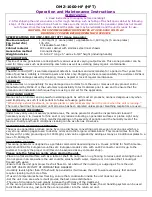
104
Service & Maintenance (Continued)
Fan Belt Adjustment
The supply fan belts and optional exhaust fan belts must be
inspected periodically to assure proper unit operation.
Replacement is necessary if the belts appear frayed or
worn. Units with dual belts require a matched set of belts to
ensure equal belt length.
When removing or installing the new belts, do not stretch
them over the sheaves. Loosen the belts using the belt ten-
sion adjustment bolts on the motor mounting base.
Once the new belts are installed, using a Browning or
Gates tension gauge (or equivalent) illustrated below; ad-
just the belt tension as follows;
WARNING
Hazardous Voltage!
Disconnect all electric power, including remote discon-
nects before servicing. Follow proper lockout/tagout
procedures to ensure the power can not be inadvert-
ently energized. Failure to disconnect power before ser-
vicing could result in death or serious injury.
1. To determine the appropriate belt deflection;
a. Measure the center-to-center shaft distance (in
inches) between the fan and motor sheaves.
b. Divide the distance measured in Step 1a by 64; the
resulting value represents the amount of belt
deflection that corresponds to the proper belt
tension.
2. Set the large O-ring on the belt tension gauge at the de-
flection value determined in Step 1b.
3. Set the small O-ring at zero on the force scale of the
gauge plunger.
4. Place the large end of the gauge at the center of the belt
span; then depress the gauge plunger until the large O-
ring is even with the top of the next belt—-or even with a
straightedge placed across the fan and motor sheaves.
Refer to Figure 5-1
.
5. Remove the belt tension gauge. The small O-ring now in-
dicates a number other than zero on the plunger’s force
scale. This number represents the force (in pounds) re-
quired to give the needed deflection.
6. Compare the "force" scale reading (Step 5) with the ap-
propriate “force” value listed in Figure 5-1. If the "force"
reading is outside the range, readjust the belt tension.
Note: Actual belt deflection "force" must not
exceed the maximum “force” value shown in
Figure 5-1.
7. Recheck the belt tension at least twice during the first 2
to 3 days of operation. Belt tension will decrease rapidly
until the new belts are “run in”.
Содержание INTELLIPAK RT-SVX10C-EN
Страница 16: ...15 Figure 3 1 Minimum Operation and Service Clearances for Single Multiple Unit Installation...
Страница 17: ...16 Figure 3 2A SAHF Cooling Only Units 20 thru 75 Ton...
Страница 19: ...18 Figure 3 2B SEHF SFHF SLHF SSHF SXHF Units 20 thru 75 Ton...
Страница 21: ...20 Figure 3 2C S_HG Cooling Heating Units 90 through 130 Ton...
Страница 25: ...24 Figure 3 4 Typical Unit Rigging Figure 3 5 Unit Base Roof Curb Section...
Страница 38: ...37 Figure 3 13 Steam Coil Piping 20 through 30 Ton Units Steam Coil Piping 40 through 130 Ton Units...
Страница 41: ...40 Figure 3 14 Continued Typical Field Power Wiring 90 thru 130 Ton Table 3 6 Customer Connection Wire Range...
Страница 52: ...51 Field Connection Diagram Notes for 20 through 130 Ton CV or VAV Applications...
Страница 86: ...84 Figure 4 6 Compressor Locations...
Страница 103: ...101 Service Maintenance Continued Table 5 3 Unit Internal Fuse Replacement Data VFD Factory Settings...
Страница 117: ...115...
Страница 118: ...116...













































